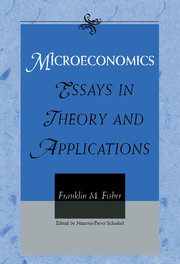Book contents
- Frontmatter
- Contents
- Introduction
- Part I Disequilibrium and Stability
- Part II Welfare Economics and Consumer Theory
- 12 Income Distribution, Value Judgments, and Welfare (1956)
- 13 Income Distribution, Value Judgments, and Welfare: A Correction (1957)
- 14 How Income Ought to Be Distributed: Paradox Lost (1961)
- 15 Advertising and Welfare: Comment (1979)
- 16 Household Equivalence Scales and Interpersonal Comparisons (1987)
- 17 Household Equivalence Scales: Reply (1990)
- 18 Normal Goods and the Expenditure Function (1990)
- Part III Applications of Microeconomic Theory
- Part IV Industrial Organization, Economics, and the Law
- Part V Public Policy Applications
- Epilogue
- Indexes
15 - Advertising and Welfare: Comment (1979)
Published online by Cambridge University Press: 20 March 2010
- Frontmatter
- Contents
- Introduction
- Part I Disequilibrium and Stability
- Part II Welfare Economics and Consumer Theory
- 12 Income Distribution, Value Judgments, and Welfare (1956)
- 13 Income Distribution, Value Judgments, and Welfare: A Correction (1957)
- 14 How Income Ought to Be Distributed: Paradox Lost (1961)
- 15 Advertising and Welfare: Comment (1979)
- 16 Household Equivalence Scales and Interpersonal Comparisons (1987)
- 17 Household Equivalence Scales: Reply (1990)
- 18 Normal Goods and the Expenditure Function (1990)
- Part III Applications of Microeconomic Theory
- Part IV Industrial Organization, Economics, and the Law
- Part V Public Policy Applications
- Epilogue
- Indexes
Summary
In their provocative article, Dixit and Norman (1978) apparently show that, for a variety of market structures, the equilibrium amount of advertising will be excessive. They demonstrate that this is so whether judged by preadvertising or postadvertising tastes. This is indeed a strong result.
A little reflection, however, shows that their result is in fact too strong, at least if it is to be interpreted in the obvious policy sense. According to Dixit and Norman (hereafter D–N), advertising merely serves as something that causes an outward shift of the demand curve. Their theorem can therefore be taken to apply to anything else that shifts the demand curve outward. Interpreted in these terms, for example, D–N have apparently shown that, for a variety of market structures, the equilibrium amount of research and development in product improvement is excessive. Surely something is wrong here.
The basis of D–N's approach is to evaluate the welfare effect of a change in output accompanying a change in advertising according to both preadvertising and postadvertising tastes. Thus, supposing U(x0) to be the preadvertising level of utility derived from the output x0 and ψ(xi) to be the postadvertising level of utility from the output xi D–N proceed to compare U(xi) with U(x0) and ψ(xi) with ψ(x0). Using a geometric analysis for the case of a monopolist, they demonstrate that U(xi) < U(x0) and ψ (Xi) < ψ(x0) and use this result to conclude that advertising is excessive whether judged by the tastes embodied in U(x) or by those embodied in ψ(x). This result is correct, as far as it goes, but it does not remove the impediment to making welfare judgments when tastes change.
- Type
- Chapter
- Information
- MicroeconomicsEssays in Theory and Applications, pp. 257 - 258Publisher: Cambridge University PressPrint publication year: 1999



